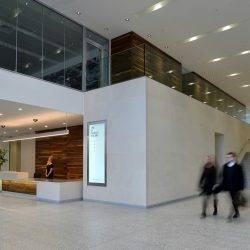November 15, 2016
Increased take-up of office space in Manchester as Brexit influences investors 0
 Take-up of prime office space in central Manchester is on course to hit 1 million sq ft in 2016 and could be influenced by the impact of Brexit. The latest research by Colliers International suggests that overseas investors retained an interest in prime Manchester office space partly because of the devaluation of sterling following the Referendum vote for the UK to leave the EU – as proven by the recent £164m acquisition of the 288,000 sq ft One St Peter’s Square by global real estate investor Deka Immobilien. There have been a series of other major deals, including an insurance firm taking 165,000 sq ft of Grade A office scheme, a global law firm moving its global centre into an 80,848 sq ft development; and a government department negotiating a 60,000 sq ft deal. The legal sector accounted for almost 25 percent of total office take-up so far in 2016, followed by media and technology (16 percent) and business services (15 percent). However, all this activity may result in a lack of ready to occupy space in the city by early 2017.
Take-up of prime office space in central Manchester is on course to hit 1 million sq ft in 2016 and could be influenced by the impact of Brexit. The latest research by Colliers International suggests that overseas investors retained an interest in prime Manchester office space partly because of the devaluation of sterling following the Referendum vote for the UK to leave the EU – as proven by the recent £164m acquisition of the 288,000 sq ft One St Peter’s Square by global real estate investor Deka Immobilien. There have been a series of other major deals, including an insurance firm taking 165,000 sq ft of Grade A office scheme, a global law firm moving its global centre into an 80,848 sq ft development; and a government department negotiating a 60,000 sq ft deal. The legal sector accounted for almost 25 percent of total office take-up so far in 2016, followed by media and technology (16 percent) and business services (15 percent). However, all this activity may result in a lack of ready to occupy space in the city by early 2017.










 The UK commercial property sector is now larger than at any time since before the last recession, claims a new analysis from the Investment Property Forum. It has risen nearly 50 percent since its lowest point in 2009 and is now valued at £871 billion, an increase of around 11 percent. The amount of stock actually shrank last year, according to the study, with the increase in overall value arising from price rises. The previous highest valuation the IPF puts on the market was £865 billion in 2006. All is not good news however as a second report from the same organisation which explores sentiment in the market following the Brexit vote confirms there is a great deal of uncertainty in the market. This is particularly acute in the London market which makes up over a third of the nation’s total and is increasingly dominated by foreign owners who may have a negative response to the UK’s vote to leave the EU. Intriguingly, the report found that total floorspace marginally declined over 2015 and has only increased by 0.9 percent since the market high of 2006.
The UK commercial property sector is now larger than at any time since before the last recession, claims a new analysis from the Investment Property Forum. It has risen nearly 50 percent since its lowest point in 2009 and is now valued at £871 billion, an increase of around 11 percent. The amount of stock actually shrank last year, according to the study, with the increase in overall value arising from price rises. The previous highest valuation the IPF puts on the market was £865 billion in 2006. All is not good news however as a second report from the same organisation which explores sentiment in the market following the Brexit vote confirms there is a great deal of uncertainty in the market. This is particularly acute in the London market which makes up over a third of the nation’s total and is increasingly dominated by foreign owners who may have a negative response to the UK’s vote to leave the EU. Intriguingly, the report found that total floorspace marginally declined over 2015 and has only increased by 0.9 percent since the market high of 2006.
 The 21st Century has seen an explosion of self employment in the UK, and most people who have become self employed have done so for positive reasons, claims a new report from the UK Government’s Office for National Statistics. According to the
The 21st Century has seen an explosion of self employment in the UK, and most people who have become self employed have done so for positive reasons, claims a new report from the UK Government’s Office for National Statistics. According to the 

















August 23, 2016
US Millennials ‘martyred’ behaviour helps drive culture of presenteeism 0
by Sara Bean • Comment, Flexible working, News, Wellbeing, Workplace
(more…)